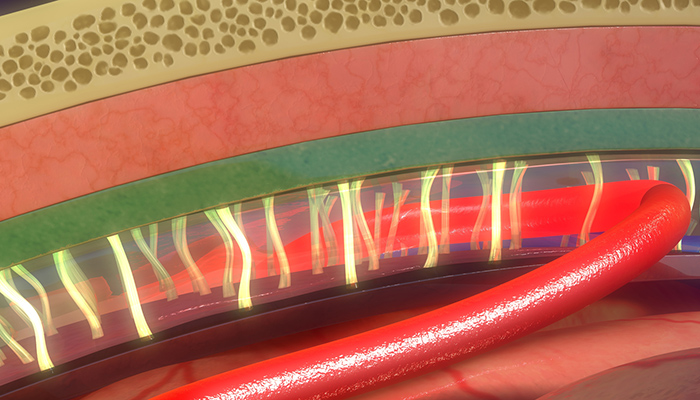What Does It Mean if an Unborn Baby Has Fluid on the Brain

The brain is precious, and evolution has gone to peachy lengths to protect it from harm. The most obvious is our 7mm thick skull, just the encephalon is besides surrounded by protective fluid (cerebrospinal – of the brain and spine) and a protective membrane chosen the meninges. Both provide further defence force against physical injury. ![]()
Another protective chemical element is the blood–encephalon barrier. As the name suggests, this is a barrier between the brain'due south blood vessels (capillaries) and the cells and other components that brand upward brain tissue. Whereas the skull, meninges and cerebrospinal fluid protect against physical damage, the blood–brain barrier provides a defence against affliction-causing pathogens and toxins that may be present in our blood.
The blood–brain barrier was discovered in the late 19th century, when the German language physician Paul Ehrlich injected a dye into the bloodstream of a mouse. To his surprise, the dye infiltrated all tissues except the brain and spinal string. While this showed that a barrier existed between encephalon and blood, it wasn't until the 1960s researchers could use microscopes powerful enough to determine the physical layer of the blood–brain barrier.
We at present know the key structure of the blood–brain bulwark that offers a barrier is the "endothelial tight junction". Endothelial cells line the interior of all blood vessels. In the capillaries that form the claret–brain barrier, endothelial cells are wedged extremely close to each other, forming and so-called tight junctions.
The tight gap allows but modest molecules, fatty-soluble molecules, and some gases to pass freely through the capillary wall and into brain tissue. Some larger molecules, such as glucose, can proceeds entry through transporter proteins, which act like special doors that open up only for particular molecules.
Surrounding the endothelial cells of the blood vessel are other components of the blood–encephalon bulwark that aren't strictly involved in stopping things getting from blood to brain, merely which communicate with the cells that course the barrier to alter how selective the blood–brain barrier is.
Why do we need it?
The purpose of the blood–encephalon barrier is to protect against circulating toxins or pathogens that could cause encephalon infections, while at the aforementioned time allowing vital nutrients to reach the brain.
Its other role is to help maintain relatively constant levels of hormones, nutrients and water in the brain – fluctuations in which could disrupt the finely tuned environment.
So what happens if the blood–brain barrier is damaged or somehow compromised?
1 mutual manner this occurs is through bacterial infection, equally in meningococcal affliction. Meningococcal bacteria can bind to the endothelial wall, causing tight junctions to open slightly. As a result, the blood–encephalon barrier becomes more porous, allowing bacteria and other toxins to infect the brain tissue, which can lead to inflammation and sometimes expiry.
It's also thought the blood–brain bulwark'south function can decrease in other conditions. In multiple sclerosis, for example, a defective blood–brain barrier allows white blood cells to infiltrate the brain and assault the functions that send messages from one encephalon cell (neuron) to another. This causes problems with how neurons signal to each other.
When exercise we need to get through it?
The claret–encephalon barrier is generally very effective at preventing unwanted substances from accessing the brain, which has a downside. The vast bulk of potential drug treatments practise non readily cross the barrier, posing a huge impediment to treating mental and neurological disorders.
1 possible style around the problem is to "fob" the blood–brain bulwark into allowing passage of the drug. This is the so-called Trojan equus caballus approach, in which the drug is fused to a molecule that tin can pass the claret–brain barrier via a transporter protein.
A different arroyo is to temporarily open the blood–brain barrier using ultrasound.
In a mouse with Alzheimer's disease, we showed that using ultrasound to open the blood–brain barrier can improve noesis and decrease the amount of toxic plaque that accumulates in the encephalon. We think this may be due to the ability of ultrasound, in combination with injected gas microbubbles, to temporarily and safely open up up the blood–brain barrier to allow protective blood-borne factors in. Importantly, this approach didn't harm the brain.
In a new study, we take shown that past temporarily opening the blood–brain bulwark, ultrasound allows more of a therapeutic antibody into the brain, improving Alzheimer's-similar pathology and knowledge more than when using ultrasound or the antibody drug in isolation.
Ultrasound is therefore a promising tool for temporarily and safely overcoming the normally very useful, but sometimes problematic, blood–encephalon barrier. It tin can be used to improve delivery of drugs to the brain, and in doing so make treatments for Alzheimer's and other brain diseases more cost-effective.
This commodity was co-authored by Dr Alan Woodruff, a science writer at the Queensland Encephalon Institute.
Jürgen Götz, Director, Clem Jones Eye for Ageing Dementia Research, The University of Queensland
This commodity was originally published on The Conversation. Read the original article.
Source: https://qbi.uq.edu.au/brain/brain-anatomy/what-blood-brain-barrier
0 Response to "What Does It Mean if an Unborn Baby Has Fluid on the Brain"
Post a Comment